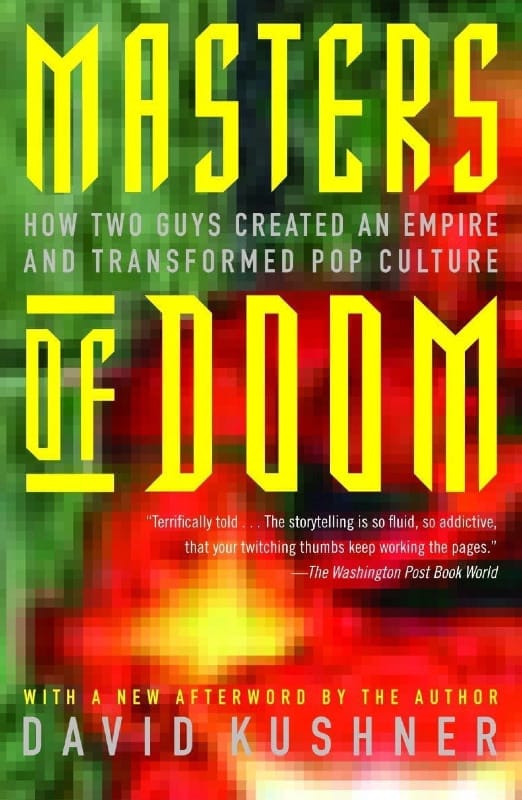"It's just a positive energy book," says John Romero of his recent autobiography Doom Guy: Life in First Person. If John Romero had written his autobiography in the nineties, it would not have been a positive energy book. Every copy would be in the landfill with the E.T. cartridges, and Romero would’ve been holding the shovel.
Today, Romero stands up for trans rights and indigenous representation, but in the nineties, Romero put swastikas in Commander Keen and Doom. When asked in an interview what it was like to have sex with his girlfriend, who was also his colleague, he gave a full reply—by email, which somehow makes it worse. What he said, and that he said it, his team says, “does not represent John Romero’s views or attitudes in 2022.”
Romero, and the world, are better for it. It’s good that he spent the nineties designing levels for games instead of writing books. He also had around a decade to practice and perfect his thing at id Software, the studio he co-founded, and be celebrated for it. The studio’s most famous products were Wolfenstein, Doom and Quake, but you can add Romero himself to that list.
If he was not video games’ first level designer, he was the first great one. He made games he wanted to play, and so he saw his levels as a player would. He would play them and revise them over and over, as a sculptor chips at marble, until all that remained was fast and furious fun. He could be a ruthless, clear-eyed editor. Stealth and subterfuge slowed down Wolfenstein 3D, so they were cut from the final game. When creative director Tom Hall struggled to align with the vision of Doom, he was cut. It was unsentimental, but correct. Doom only feels like Doom when played at high speeds, where you’re charging across lava while mowing down zombies with a chaingun and trading rockets with a demon, learning the rules while in awe of the spectacle.
A Romero level must be, in the first place: an intricate and intentional 3D labyrinth packed with contrast and spectacle, spatially coherent and intuitively navigable, that teaches the player while trying to kill them, with a roller-coaster core path plotted through it. That same level must not break, but get better, when all the enemies are removed and the space is made an empty battlefield for a free-for-all multiplayer deathmatch. Because this is where the stories happen.
“When you make a space that people are going to play through, every player’s run-through is a different story,” he’s said. “How many stories took place in Doom’s [first level] over the past 25 plus years? Whether it's deathmatch or single-player, or anybody’s unique way of going through there, these 3D spaces let millions of people create their own stories in them for decades.”
Few game designers ever reach, or are comfortable with, Romero’s level of fame, and fewer still get book deals for their memoirs. Romero has been the subject of biography before. The journalist David Kushner’s accessible, appealing history of id Software, Masters of Doom, functioned as a joint biography of Romero and his id co-founder, programmer John Carmack. In Kushner’s telling, Carmack was order and Romero chaos, a trash-talking, highly bankable young gamer whose games were a fixture of computer labs, frat houses, and congressional hearings on gun violence, who found the culture in want of a video game rock star and grew to fill the vacuum. “You could see it happening over the course of time,” Jay Wilbur, id’s first CEO, told the Dallas Morning News in 1997. “It was a look he cultivated, the long hair, the duster coat, the fast cars. The next thing you know, we had a guy who looked like ZZ Top walking around the office.”

Romero today dismisses the “rock star” thing, but at one point he did peacock around a Doom tournament in a T-shirt with the game’s logo on the front and the words “WROTE IT” on the back. He then told the Austin American-Statesman he was there “so we can beat everybody.” Kushner recalled his fans bowing and chanting at his feet: “We’re not worthy. We’re not worthy.”
“Here were all these people,” wrote Kushner, “who loved games as much as he did.” But here was the gamer so good he made the games the gamers loved.
A sticking point with Romero’s colleagues was that he spent too much time playing games — but if he had not, he would not have been, as he was known online, “The Romero.” “He is the most intense gamer you’ll ever know. It’s a sport for him. He builds muscles playing games,” Wilbur said.
Romero is the rare game developer whose fame rested in large part on his talent as a player. “Furious feuding surrounds the title of in-house Quake champion,” reported Wired in 1996. “Romero’s reputation as an unmatched Doom champ… is an essential part of the id legend. Gears of War designer Cliff Bleszinski recalls seeing Romero as his “enemy” whom he nonetheless studied, as George C. Scott’s idealized Patton did Rommel, to defeat. “I had nothing and I wanted it,” he remembers feeling. “You had everything and you flaunted it.”
Rarer still is that he was a game developer who thrived on calling his fans motherfuckers. “The trash-talk is foul and funny, witty and misogynist, [sic] homophobic and democratic, and unremittingly non-personal,” recalled Romero’s childhood friend Christian Divine, who went on to write at Romero’s post-id studio Ion Storm. “I can understand being horrified by the scene,” Divine remembers. “However, when somebody shouts out ‘Suck it down, cocksucker. Your ass is mine!’ right before they splatter your player into bloody gibs, it's really little more than the geek equivalent of athletic taunting. Part of the gamer's code is to not take this personally.”
When Romero split, not amicably, from id Software and Carmack, he took these fans and made them colleagues. “I, we — all of us — loved Romero,” Sverre Kvernmo, a Romero fan turned Ion Storm level designer, told Wired in 1998. That Wired reporter found Kvernmo and Romero at the office, engaged in deathmatch, with the loser to “drink rotten milk out of a jug that’s been sitting there for months.”
At Ion Storm, Romero dreamed beyond his gifts. The studio was an unfocused and expensive fiasco. Daikatana was supposed to be the greatest John Romero deathmatch shooter ever made and with “an epic storyline with time travel, fleshed-out characters, and many twists and turns” — all things he once had the presence of mind to know did not help him. Romero’s success as a first-person-shooter designer was to think ahead of the curve, to push the genre into faster, bloodier currents. At Ion Storm, he became just another game developer who had no idea how to tell a story.
With Daikatana and Ion Storm, the inveterate gamer lost, and they lost hard. The fall from grace bodied his career and goodwill for a generation. The gamers he had risen up to soldiers now devoured him like the pack of hyenas did to The Lion King’s Scar. Romero had it until he didn’t; he won until he lost.
This is the Romero story, per Kushner. It’s a tidy Greek (geek) tragedy with a beginning, middle, end, and moral. In a sense, it’s all anybody needs to know about John Romero. We tell ourselves stories in order to live, we look for meaning in the mire of John Romero’s career. Now Romero has written an autobiography to say not to do that. Doom Guy is a corrective to the narrative of Masters of Doom — at points, explicitly so. It’s also a corrective to storytelling and editing. John Romero is not a story, he is a person; Icarus was more than the sun, and Romero is more than just an idol who fell from grace.
This content is for registered subscribers only
Register now to access "The Simple Truth According to John Romero".
Sign up now Already have an account? Sign in